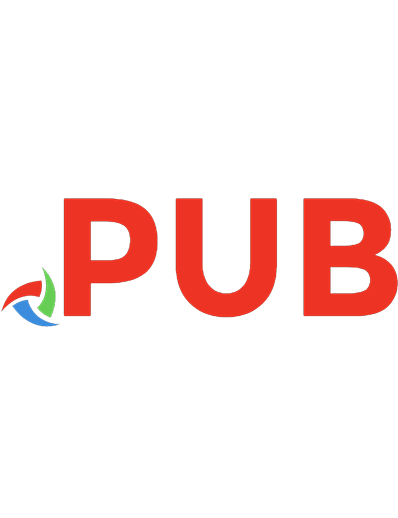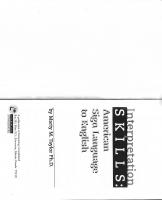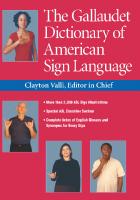American Sign Language Conversation. 9781423228554, 1423228553
591 86 19MB
English Pages [6] Year 2015
Polecaj historie
Table of contents :
ALPHABET
THE CONDITION
NAME SIGNS
LEARNING ASL
GENERAL RULES
AGENTS
VERBS
NEGATION & AFFIRMATION
SENTENCE STRUCTURE
Indexing
Possessive Pronouns
Loan Signs
Classifiers
Non-Manual Markers
NUMBERS
DAYS OF THE WEEK
BASIC CONVERSATIONAL PHRASES
Citation preview
AMERICAN Sign Language WORLD’S #1 ACADEMIC OUTLINE
Essentials of ASL from rules and guidance to important subtleties of signs and sentences with photos for instruction
ALPHABET ●● Fingerspelling is a basic skill of American Sign Language (ASL). ●● Before learning signs, it is appropriate to learn the signs for each letter and get comfortable with the handshapes. ●● Be mindful of the letters “a” and “e” and pay close attention to the placement of your thumb when signing these letters. ●● Use fingerspelling for names, places, or words you do not know the sign for, but do not fingerspell every word for every sentence.
— KEY —
(2 X): Repeat sign or signs in same order twice (Tap 2 X): Tap sign twice on part of body shown
A
B
C
D
E
F
G
H
I
J
K
L
M
N
O
P
Q
R
S
T
U
V
W
X
Y
Z
THE CONDITION
Tip!
Pick a partner and practice fingerspelling random words to improve your receptive skills.
LEARNING ASL
●● The hand you write with is your dominant hand; therefore, this will be the hand you use for fingerspelling or for one-handed signs. The other hand is considered passive. ●● There are three types of signs: one-handed, two-handed symmetrical, and two-handed non-symmetrical. ●● Dominance condition: If both hands don’t have the same handshape, then the dominant hand is the only one that moves while the passive hand stays in place. ●● Symmetry condition: If both hands of a sign move, then both hands must have the same shape, move alternately or in the same direction, AND be in the same location.
GENERAL RULES ●● There are five basic sign parameters used for each sign to convey meaning. ––Handshape ––Movement ––Palm orientation: Position of your palm ––Location ––Non-manual markers: Facial expressions and body language/movement ●● Verbs have a single motion. ––They are not mouthed; mouth movement is used to express adjectives, adverbs, and nouns.
CHAIR (2 X)
PLANE (2 X)
NAME SIGNS ●● Name signs date back to the19th century. ●● They are used for identification and are a distinct part of Deaf Culture. ●● While people can come up with their own name signs, it is more culturally appropriate to get your name sign assigned to you by a member of the Deaf community. ●● A person’s name sign can change over time. ●● Arbitrary name signs (ANS) ––Use the manual alphabet (can be two letters but must be signed with a double motion) ––Sign is located on the body or in front of the signer ●● Descriptive name signs (DNS) ––Depict information about personality or physical characteristics (e.g., employment or habits) ––Are signed with a double motion ––Proper names need to be introduced before a name sign is used. ––Name signs at the top of the head are usually reserved for males and name signs at the lower part of the head are reserved for females. A
M
STORE (2 X) SIT
●● Adjectives: In contrast to the English language, adjectives can be signed after the noun. EX: HE HAS BLUE PANTS.
PANTS (2 X)
FLY
BLUE
Y
SELL
●● Nouns have smaller movements. ––They are repeated (tapped twice) with a double motion. ––They are usually “mouthed” or pronounced. 1
HE
HAS
LEARNING ASL (continued) ●● Adverbs can be signed using inflection. ––Inflection is used to modify the meaning of signs. ◊ The sign can be modified through the speed or direction. EX: VERY SLOW can be signed using the SLOW sign in a much slower movement.
VERBS ●● In ASL, verbs take on different functions. ––Plain verbs: These are normal verbs in ASL. EX: PLAY, WRITE, BREAK
EX: THROW: You can show the speed and direction the object was thrown.
THROW LOW
THROW HIGH
NEGATION & AFFIRMATION
PLAY
●● When the sign “not” is put at the end of a sentence, negation is added.
SLOW
◊ Inflect signs using facial expressions. EX: You can indicate the intensity of someone’s anger using facial expressions. VERY ANGRY can be conveyed with an exaggerated expression of anger. NOT
WRITE (2 X)
ANGRY
●● Sometimes, the head shaking “no” will be signed with “not.” You can shake your head “no” instead of signing “not” to add negation. EX: I AM EXCITED (while shaking your head) means I AM NOT EXCITED.
VERY ANGRY
AGENTS ●● To personify a sign, add an agent after the sign. ●● Personification is done by sliding the heel of the hands down the side of the body from chest to waist. ●● An agent is also known as a marker. ●● Sign + agent = person
BREAK
––Inflecting/Indicating verbs: These allow the signer to sign a sentence using one motion. EX: GIVE can mean I GIVE TO YOU or YOU GIVE TO ME using directionality.
NOT EXCITED
I
●● Affirmation is usually done with the signer making a statement and then signing “will” at the end of the sentence. EX: I WILL GO TO THE STORE.
AGENT I GIVE TO YOU
I
GO
PREACH + AGENT = PREACHER
YOU GIVE TO ME
◊ The signer uses both hands in the same handshape. One hand represents the signer, while the other hand represents the addressee. DRIVE + AGENT = DRIVER
TEACH + AGENT = TEACHER
STORE (2 X)
EX: MEET ME
WILL
MEET ME
––Spatial verbs: You show the location of the verb. FLY + AGENT = PILOT Note: This rule does not apply in all situations. EX: DOCTOR and NURSE don't have an agent signed after them.
EX: HURT: You can sign the word HURT on your jaw or forehead to show what hurts.
●● Head nodding slightly backward and forward with the eyebrows raised are also appropriate non-manual markers. ●● You can sign “true” at the end of the sentence while using such non-manual markers as a head nod with tight lips (to emphasize a statement).
TRUE HURT DOCTOR (Tap 2 X)
HEADACHE
NURSE (Tap 2 X) 2
SENTENCE STRUCTURE There are several sentence structure types in ASL; here are a few: ●● Topic comment
––A signer can preface a sentence by signing the topic followed by a comment about the topic. EX: THAT OLD MAN STOLE MONEY FROM A BANK.
EX: WHAT HAPPENED? (neutral expression)
HERE
THAT
●● Wh- questions ––Questions which ask who, what, when, where, why, and how are asked at the beginning or end of the sentence.
HAPPEN
WHAT
MY CAT DIED. (sad expression)
EX: WHAT IS YOUR NAME?
MAN
YOUR
NAME (2 X)
WHAT
EX: WHY MOW THE GRASS?
STEAL
CAT (2 X)
MY
OLD
GRASS (2 X)
MOW
DIE
––If the signer is asking a rhetorical question, the head will be tilted to the side or forward and the eyebrows up. ––Sometimes it takes a more fluent signer to understand that the question is rhetorical. ●● Time indicator sentences ––These sentences start with time adverbs. ◊ Time adverbs: Now, soon, tomorrow, next year, last summer, recently ––If time is not signed at the beginning of the sentence, it should be placed as close to the subject as possible (in ASL, the subject will be at the beginning of the sentence). EX: MY DAD WILL HELP SOON.
MONEY (2 X)
WHY
EX: WHO DID YOU MARRY? SOON
MY
DAD (Tap 2 X)
FROM WHO (2 X)
YOU HELP
EX: I WENT ON A VACATION LAST SUMMER.
BANK
●● Yes/No question ––The appropriate non-manual markers are head tilted forward, shoulders raised, and eyebrows up; the eyes will naturally open more than usual. EX: ARE YOU A STUDENT HERE?
MARRY
––There will usually be a “hold” (pause) after the question at the end of the sentence—this is done for emphasis. ––The head is tilted to the side and the eyebrows are down and close together.
HOW
YOU
STUDENT
WHEN
SUMMER
GO
WHERE 3
LAST
VACATION (2 X)
I
––The time indicator will allow the addressee to understand if the sentence is past, present, or future. ◊ Signs behind the body refer to the past. ◊ Signs directly in front of the body refer to the present, today, or now. ◊ Signs extended in front of the signer refer to the future. Like the signs that are extended behind the body for the past, the extension of the arm determines the degree of how far past or how far into the future. ◊ Facial expression will assist the time indicator. EX: I WENT TO COLLEGE LONG AGO.
LOOK AT (long time)
PAY ME
●● Simple sentence structure ––This short sentence can use any word order. ––A simple sentence will have a subject (referent) and verb (action concerning the referent). EX: THE BOY RUNS.
LONG
BOY (2 X)
RUN (2 X)
AGO
RUN (2 X)
BOY (2 X)
I
GO
●● Finish/Not yet ––“Finish” allows the addressee to understand that the information is in the past tense. ◊ It is signed when joking, meaning “enough already.” ◊ It is signed in admonishment, meaning “stop it.” ◊ Context and facial expression will determine the signer’s intention. ◊ “Finish” can be placed at the beginning or end of a sentence.
Indexing
●● Pronouns in ASL can be signed by pointing to a referent; this is also called indexing. ––If you point at someone in your presence, that will be the sign for “he” or “she.” ––If you are pointing at someone or something that is not there, preface the pointing with fingerspelling the name or describing the person you are “pointing at.” From that point on in the conversation, you can point in the same direction to denote that you are talking about that person or thing. EX: YESTERDAY, I MET TOM. (After fingerspelling T-OM, you point to your left.) TOM (point to your left to indicate you are talking about TOM), FUNNY MAN.
YESTERDAY
MEET
I
T
O
M
COLLEGE
●● Conditional sentences (if/then statements) ––Like the topic/comment, conditional sentences are stated in two parts. ––Conditional sentences must have the condition first. ––The comment will always be about the referent in the condition (the first part). ––Generally, conditional sentences are futuristic. ––When signing the condition, eyebrows should be raised. They are lowered with comments about the condition.
FINISH
––“Not yet” refers to an action that has not taken place. ◊ The intended action is signed, then “not yet” is stated. ◊ It is placed at the end of the sentence. ◊ It is usually signed with the head shaking “no” slightly and the mouth opened.
MAN
EX: IF YOU BREAK THE TABLE, YOU WILL PAY ME.
NOT YET
●● Temporal aspect (temporal means time) ––Found in the predicate of a sentence, as verbs come after the noun in ASL. ––Tells how the action is performed. ––Explains how the action is signed in reference to time.
IF (2 X)
FUNNY (2 X)
●● Indexing can be done with a finger, a head nod, or eye gazing (visual indexing). ●● Be consistent with indexing. If you change where you were pointing, it can confuse the people conversing with you.
Possessive Pronouns
●● Singular ––To express possessive pronouns, an open hand toward the referent indicates his or hers. ––A hand on one’s chest indicates mine. ●● Plural possessive is shown with the open hand toward one referent; the hand makes a sweeping motion inclusive of all referents.
BREAK
LOOK AT (over time)
INDEXING TABLE (2 X)
YOU
LOOK AT (regularly) 4
SINGULAR
PLURAL
●● As in English, a pronoun in ASL requires a noun to be stated before a pronoun can be used.
LEARNING ASL (continued)
Loan Signs
●● All languages “borrow” from each other; loan signs are words borrowed from English or other countries. ●● In ASL, they are usually two letters: the first and last. EX: “OK” “OH” “IF” “TB (Too Bad)”
OK
OH
IF
TB (Too Bad)
––There is usually a distinct hand movement for words that are borrowed and have more than two letters. EX: Country signs such as “CHINA” or “JAPAN”
CHINA
JAPAN
Classifiers
●● Classifiers express and represent descriptive qualities of nouns (referents); their shapes, sizes, degree of color, actions, and locations in space; and whether they are singular or plural. ●● In many ASL books, you will see classifiers represented as CL followed by the handshape used. EX: CL-O means a classifier using the “O” handshape, which can be used to mean “a hole.” ●● Before using a classifier, a subject noun must be identified (just as pronouns need a referent). ––Before showing the size of a hole in the wall, point to your classifier and fingerspell “h-o-l-e” to signify what it represents. Classifiers are not signs by themselves.
◊ A single hole can be represented by one hand, while multiple holes can be used by both hands to demonstrate a hole in the plural form. ◊ If you want to show a large hole, form the “C” handshape with both hands. The symbol for this would be CL-CC. There are two C’s because you are using both hands. ◊ There may be a description following the handshape symbol, such as CL-3 (clawed fingers). You would use the “3” handshape in the form of a claw. This can be used to represent someone holding a ball in their hand. Using the CL-3 (clawed fingers) handshape, you can demonstrate if someone is throwing the ball fast or slow.
CL-3
CL-CC
NUMBERS ●● In the numerical system, 1 through 5 are signed with the palm facing the signer. ●● Numbers 6 through 10 are signed with the palm facing the addressee. ●● Numbers 11 through 15 are NUMBERS signed with the palm facing the signer. ●● Numbers 16 through 19 are signed using the same signs as numbers 6 through 9, but in a repeated motion. ●● The number 20 is signed with the index finger and the thumb tapping two times.
0
1
2
3
4
5
6
7
8
9
10
●● Other examples of classifiers:
CL-1
CL-LL
CL-V (bent fingers)
Non-Manual Markers
●● Facial grammar, body language, and eye contact contribute to well over 50% of sign language expressed by a fluent signer, which is why this is one of the most critical components of American Sign Language. ●● Fluent signers tend to look at the facial, throat, and shoulder areas when watching other signers because much information can be expressed through these body parts. ●● Facial expression covers many components in a message. ––It indicates how an action was performed, how quickly it was performed, and if it was performed conscientiously or carelessly. ––It can indicate the degree in size, shape, and color. ––It can indicate that you are asking a question. ●● Adverbs and adjectives can be expressed through facial expression. ●● Eye contact has importance of its own; eye shifting, eye indexing, eyes wide open, eye gazing, eye squinting, and breaking eye contact all work together with body language and head movement to set up referents of people and objects in a spatial location. ●● Body language is equally important; tilting the head, raising the shoulders, and body shifting are all indications of change in a sentence or who is being talked about. ––When telling a story that has two or more characters, signers shift the positions of their bodies to indicate that someone new is speaking. EX: If a signer is telling a story about a conversation between him and his boss, the signer will use one position to indicate it’s him talking and then shift to another position to indicate that it’s his boss that is talking. ●● If using facial expressions in a more exaggerated way feels unnatural, it just means you need more practice. 5
11
12
13
14
15
16
17
18
19
20
DAYS OF THE WEEK ●● Days of the week act as time indicators and should be placed at the beginning of the sentence.
SUNDAY
MONDAY
TUESDAY
WEDNESDAY
Tip!
For more practice signing, search for ASL clubs in your area. Often people meet up once a week or month at a coffee shop to practice signs. THURSDAY
FRIDAY
TOMORROW
SATURDAY
WEEK
TODAY
WEEKEND
BASIC CONVERSATIONAL PHRASES EX: WHERE DO YOU LIVE?
YOU
LIVE
HOW ARE
WHERE
YOU
EX: WHAT DO YOU LIKE?
Tip!
THANK YOU
YOU
LIKE
WHAT?
A great way to improve on your signing is to look for volunteer opportunities at summer camps that support children or adults with hearing loss.
EX: WHERE ARE YOU FROM? PLEASE
YOU
WHERE
FROM
HELLO
EX: DO YOU NEED HELP?
NEED
GOODBYE
HELP YOU
U.S. $6.95 Author: David Alianiello
NOTE TO STUDENT: This guide is intended for informational purposes only. Due to its condensed format, this guide cannot cover every aspect of the subject; rather, it is intended for use in conjunction with course work and assigned texts. BarCharts, Inc., its writers, editors, and design staff are not responsible or liable for the use or misuse of the information contained in this guide. All rights reserved. No part of this publication may be reproduced or transmitted in any form, or by any means, electronic or mechanical, including photocopying, recording, or any information storage and retrieval system, without written permission from the publisher. Made in the USA ©2018 Barcharts, Inc. 0818
6
For more words, phrases, and how to use them, see our American Sign Language First 100 Words and American Sign Language Conversation guides!

![American Sign Language Dictionary [Unabridged]
0062716085, 9780062716088](https://dokumen.pub/img/200x200/american-sign-language-dictionary-unabridged-0062716085-9780062716088.jpg)








